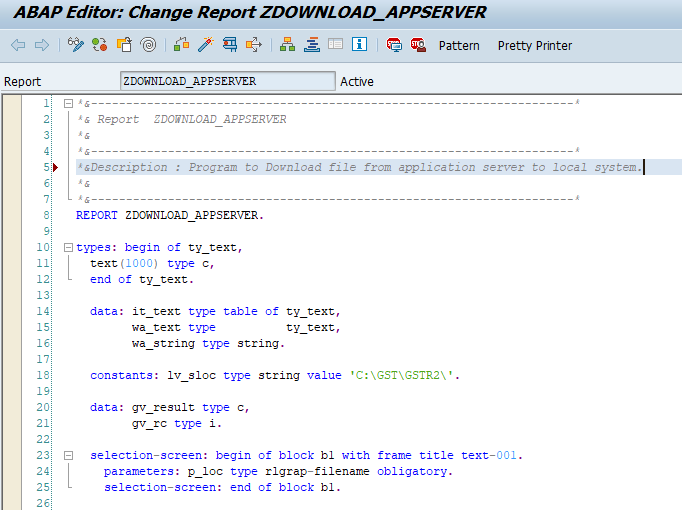SAP ABAP Program: Downloading Files from Application Server to Local System.

In This Article we will see how to Download Files from Application Server to Local System by using SAP ABAP Program.
Table of Contents
SAP ABAP Program: Downloading Files from Application Server to Local System
In SAP ABAP, there are so many times when user or functional need to transfer files between the application server and the local system.
This could be to back up important data, generate reports, or share files with external systems. In this article we will explore how to create an ABAP program that allows us to download files from the application server to the local system effortlessly.
SAP ABAP Program Downloading files from application server to local system we have to follow the below steps.
STEP 1: Files Selection(SAP ABAP Program Downloading Files from Application Server to Local System)
This First step is to enable users to select the file they wish to download from the application server. We can user the standard SAP Function Module “/SAPDMC/LSM_F4_SERVER_FILE” which is use to create file selection dialog from the application server, allowing users to choose the desired file. If you want to choose file from your local system then you can user Function Module “F4_FILENAME” to create a file selection dialog. This function module opens a file dialog box, allowing users to choose the desired file.

STEP 2: Read File Content(SAP ABAP Program Downloading Files from Application Server to Local System)
Once the user select the file, the next step to read its content from the application server. We can do this by using “OPEN DATASE” then “READ DATASET” and then finally “CLOSE DATASET“.

STEP 3: Download the File(SAP ABAP Program Downloading Files from Application Server to Local System)
After reading the file content into a internal table, we can then download the file to the local system using the “GUI_DOWNLOAD” function module. This modules saves the file to the local system with the specified file path and name.

*&———————————————————————*
*& Report ZDOWNLOAD_APPSERVER
*&
*&———————————————————————*
*&
*&
*&———————————————————————*
REPORT ZDOWNLOAD_APPSERVER.
types: begin of ty_text,
text(1000) type c,
end of ty_text.
data: it_text type table of ty_text,
wa_text type ty_text,
wa_string type string.
constants: lv_sloc type string value ‘C:\GST\GSTR2\’.
data: gv_result type c,
gv_rc type i.
selection-screen: begin of block b1 with frame title text-001.
parameters: p_loc type rlgrap-filename obligatory.
selection-screen: end of block b1.
At selection-screen on value-request for p_loc.
CALL FUNCTION ‘/SAPDMC/LSM_F4_SERVER_FILE’
EXPORTING
DIRECTORY = p_loc
IMPORTING
SERVERFILE = p_loc
EXCEPTIONS
CANCELED_BY_USER = 1
OTHERS = 2
.
IF sy-subrc <> 0.
* Implement suitable error handling here
ENDIF.
START-OF-SELECTION.
open dataset p_loc for input in text mode encoding default.
if sy-subrc ne 0.
message ‘file not found’ type ‘E’.
else.
do.
read dataset p_loc into wa_string.
if sy-subrc ne 0.
exit.
else.
if wa_string is not initial.
wa_text-text = wa_string.
append wa_text to it_text.
clear wa_text.
endif.
endif.
enddo.
endif.
BREAK-POINT.
CLEAR : gv_result, gv_rc.
CALL METHOD cl_gui_frontend_services=>directory_exist
EXPORTING
directory = lv_sloc
RECEIVING
result = gv_result
EXCEPTIONS
cntl_error = 1
error_no_gui = 2
wrong_parameter = 3
not_supported_by_gui = 4
OTHERS = 5.
IF sy-subrc = 0.
IF gv_result <> ‘X’.
CALL METHOD cl_gui_frontend_services=>directory_create
EXPORTING
directory = lv_sloc
CHANGING
rc = gv_rc
EXCEPTIONS
directory_create_failed = 1
cntl_error = 2
error_no_gui = 3
directory_access_denied = 4
directory_already_exists = 5
path_not_found = 6
unknown_error = 7
not_supported_by_gui = 8
wrong_parameter = 9
OTHERS = 10.
IF sy-subrc <> 0.
* MESSAGE ID SY-MSGID TYPE SY-MSGTY NUMBER SY-MSGNO
* WITH SY-MSGV1 SY-MSGV2 SY-MSGV3 SY-MSGV4.
ENDIF.
ENDIF.
ENDIF.
data(lv_filename) = |{ lv_sloc }| && |test.txt|.
CALL FUNCTION ‘GUI_DOWNLOAD’
EXPORTING
* BIN_FILESIZE =
filename = lv_filename
FILETYPE = ‘DAT’
* APPEND = ‘ ‘
* WRITE_FIELD_SEPARATOR = ‘ ‘
* HEADER = ’00’
* TRUNC_TRAILING_BLANKS = ‘ ‘
* WRITE_LF = ‘X’
* COL_SELECT = ‘ ‘
* COL_SELECT_MASK = ‘ ‘
* DAT_MODE = ‘ ‘
* CONFIRM_OVERWRITE = ‘ ‘
* NO_AUTH_CHECK = ‘ ‘
* CODEPAGE = ‘ ‘
* IGNORE_CERR = ABAP_TRUE
* REPLACEMENT = ‘#’
* WRITE_BOM = ‘ ‘
* TRUNC_TRAILING_BLANKS_EOL = ‘X’
* WK1_N_FORMAT = ‘ ‘
* WK1_N_SIZE = ‘ ‘
* WK1_T_FORMAT = ‘ ‘
* WK1_T_SIZE = ‘ ‘
* WRITE_LF_AFTER_LAST_LINE = ABAP_TRUE
* SHOW_TRANSFER_STATUS = ABAP_TRUE
* VIRUS_SCAN_PROFILE = ‘/SCET/GUI_DOWNLOAD’
* IMPORTING
* FILELENGTH =
tables
data_tab = IT_TEXT
* FIELDNAMES =
EXCEPTIONS
FILE_WRITE_ERROR = 1
NO_BATCH = 2
GUI_REFUSE_FILETRANSFER = 3
INVALID_TYPE = 4
NO_AUTHORITY = 5
UNKNOWN_ERROR = 6
HEADER_NOT_ALLOWED = 7
SEPARATOR_NOT_ALLOWED = 8
FILESIZE_NOT_ALLOWED = 9
HEADER_TOO_LONG = 10
DP_ERROR_CREATE = 11
DP_ERROR_SEND = 12
DP_ERROR_WRITE = 13
UNKNOWN_DP_ERROR = 14
ACCESS_DENIED = 15
DP_OUT_OF_MEMORY = 16
DISK_FULL = 17
DP_TIMEOUT = 18
FILE_NOT_FOUND = 19
DATAPROVIDER_EXCEPTION = 20
CONTROL_FLUSH_ERROR = 21
OTHERS = 22
.
IF sy-subrc <> 0.
* Implement suitable error handling here
ENDIF.





You May Also Like:
- CDHDR object class list
- Cdpos and Cdhdr table in SAP
- F4IF_INT_TABLE_VALUE_REQUEST search help
- Program To Upload File In Al11 In SAP ABAP
For the next blog please connect with us and follow us on twitter.com/einfonett

